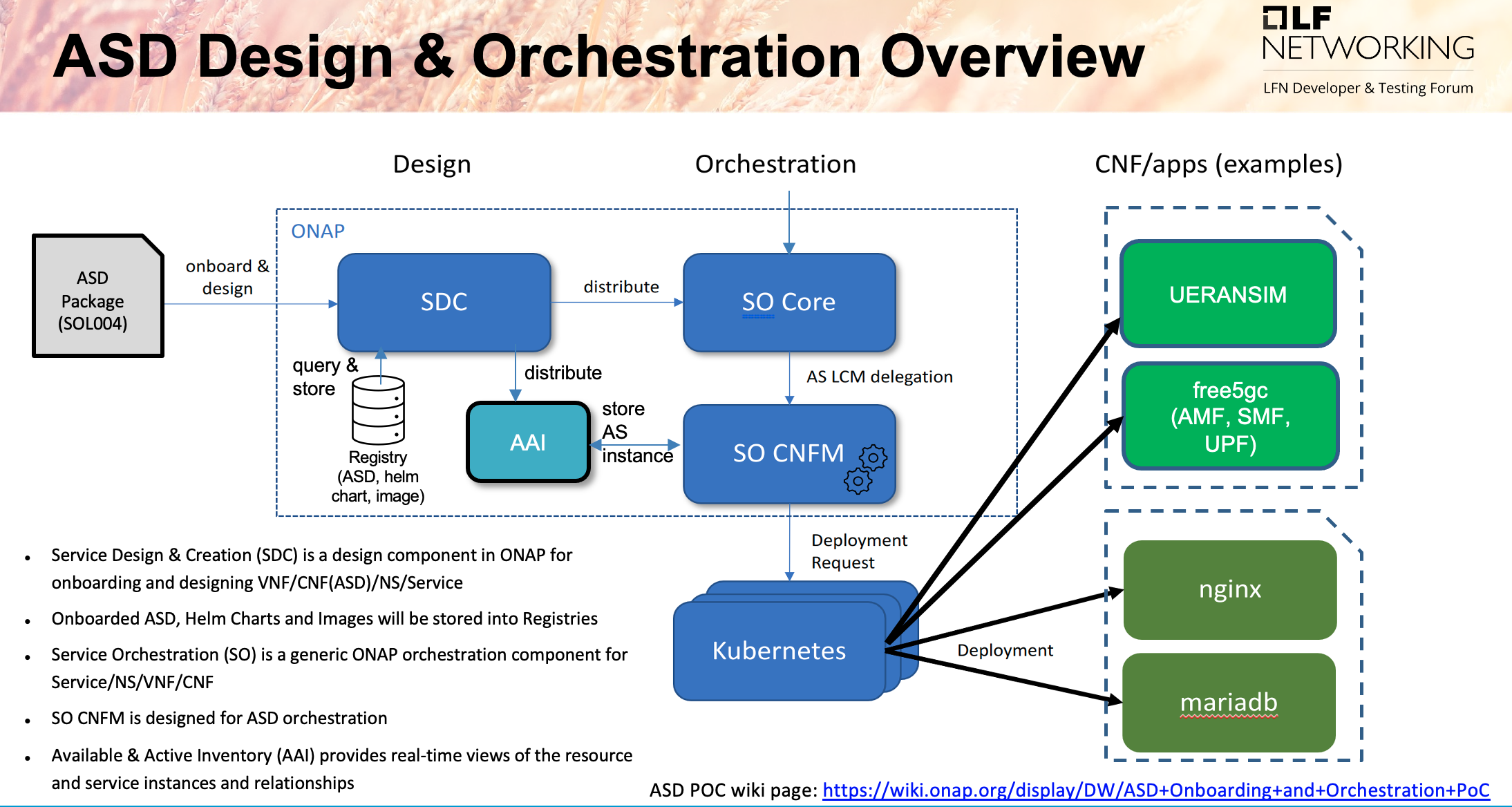Page Status: Updated for Montreal -
Component Status: Approved
Last Reviewed:
Certified by:
1. High Level Component Definition and Architectural Relationships
2. API Definitions
2a. Exposed APIs
| Interface Name | Definition | Capabilities | Version | Status | Payload Model(s) | API Spec (Swagger) |
|---|---|---|---|---|---|---|
| SO-E-01 | Service and Resource order requests | Service Instance management (Service, Volume Group, VF Module, VNF, PNF and CNF) Health check, global and node. Infrastructure provider management (Certificates, networks, sub-networks, security groups) | 3.1.2 | Production | Embedded in interface | Swagger,json |
| SO-E-02 | SO maintenance requests | Monitoring of the SO BPMN flows. Upload of new recipe war files. | 8.0.0 | Development and Evaluation | Embedded in interface | Monitoring_Swagger.json |
2b. Consumed APIs
| Interface Name | Description |
|---|---|
| SDCE-6 | Service/Resource model notification |
| POE-5 | Delegation of decision to policy logic |
| OOF-HAS | Delegation of placement decision |
| AAIE-1 | Ingest/update state of services and resources |
| MCE-2 | Assign and configure infrastructure resources |
| CONE-3 | Assign and configure network resources |
| APPC | Assign and configure resources (Using APPC library hosted in BPMN) [Yang, REST, DMaaP] |
| VFCE-2 (SOL005) | Delegation of Network Service LCM |
| SOL003 | Delegation of VNF LCM to VNFM |
| SDCE-7 | Service/Resource model query |
| etsicatalogAPIE-1 | Catalog API Provides catalog management interface:
|
| etsicatalogAPIE-2 | NSD Management API Provides NSD management interface (Align with ETSI SOL-005)
|
| etsicatalogAPIE-3 | VNF Management API Provides VNF management interface (Align with ETSI SOL-003)
|
| etsicatalogAPIE-4 | Parser API Provides Parse interface:
|
3. Component Description
Orchestration is the execution of various modules capabilities in harmony as a consolidated process to accomplish the desired tasks. The Service Orchestrator (SO) component of ONAP provides orchestration at a very high level, with an end to end view of the infrastructure, network, and applications.
SO's primary function is the automation of end-to-end service instance provisioning activities. SO is responsible for the instantiation and configuration of VNFs in support of overall end-to-end service instantiation, operations and management. SO executes well-defined processes to complete its objectives and is typically triggered by the receipt of service requests generated by other ONAP components or by Order Lifecycle Management in the BSS layer. The orchestration procedure is either created manually or obtained from the Service Design and Creation (SDC) component of ONAP, where all service designs are created and exposed/distributed for consumption
Internally, SO is organized as a set of modules with well defined responsibility. External adapters (SDNC, OpenStack, VFC and SOL003) encapsulate most communication with external systems. Persistence is exposed to other SO modules – not externally, by DB adapters (Catalog and Request). The underlying workflow component resides in the BPMN Execution Engine. The BPMN Execution Engine also interacts with other ONAP systems such as App controllers, AAI and OOF-HAS. Interactions with SNC are hosted by the SDC Controller. Likewise the API Request Handler exposes SOs API for interaction with clients. Finally there is also a monitoring component that allows insight into the execution state of workflows.
4. Known System Limitations
https://docs.onap.org/projects/onap-so/en/latest/release-notes.html#release-notes
5. System Deployment Architecture
https://docs.onap.org/projects/onap-so/en/latest/architecture/architecture.html
6. New Release Capabilities
The new enhancements proposed
| Key | Summary | Assignee | Reporter | Fix Version/s |
| SO-4048 | SO and its sub-components shall support ASD-based CNF lifecycle orchestration | Byung-Woo Jun | Byung-Woo Jun | |
| SO-4037 | Support 3GPP 28.532 APIs for slicing use case | Sanchita Pathak | Sanchita Pathak |
1. SO-4048 : SO and its sub-components shall support ASD-based CNF lifecycle orchestration
Supported Features in SO:
- Create AS
- Instantiate AS
- Terminate AS
- Delete AS
Impact on SO project:
Code changes to be done in:
1. SO api-handler
2. BPMN infra
3. SO CNFM
Impacted components:
SO (Code change)
SO CNFM (Code change) - new optional SO sub-component
AAI (Test only)
SDC (Test only)
2. SO-4037 : Support 3GPP 28.532 APIs for slicing use case
Proposal is to build an O-RAN specific Macro flow-based NSSMF which can integrate with an external NSMF. What’s the difference ??
• Current ONAP slicing use case is using 3GPP 28.531 APIs (Slice-Specific APIs) And we are proposing 3GPP 28.532 APIs (as per Generic Provisioning APIs based on Managed Object Instances (MOI))
• We propose changes in SO Macro flow building blocks to implement slicing workflows
Impact on SO project:
SO macro flow can support 3GPP 28.532 APIs for slicing use case along with the existing 3GPP 28.531 APIs.
Code changes to be done in:
1. SO api-handler
2. BPMN infra
3. cataloged
Impacted components:
SO (Code change)
OOF (Code change)
CDS(Test only)
AAI (Test only)
CDS (Test only)
Multicloud (Test only)
SDC (Test only)
ARC Service Orchestrator Component Description - Montreal-R13



